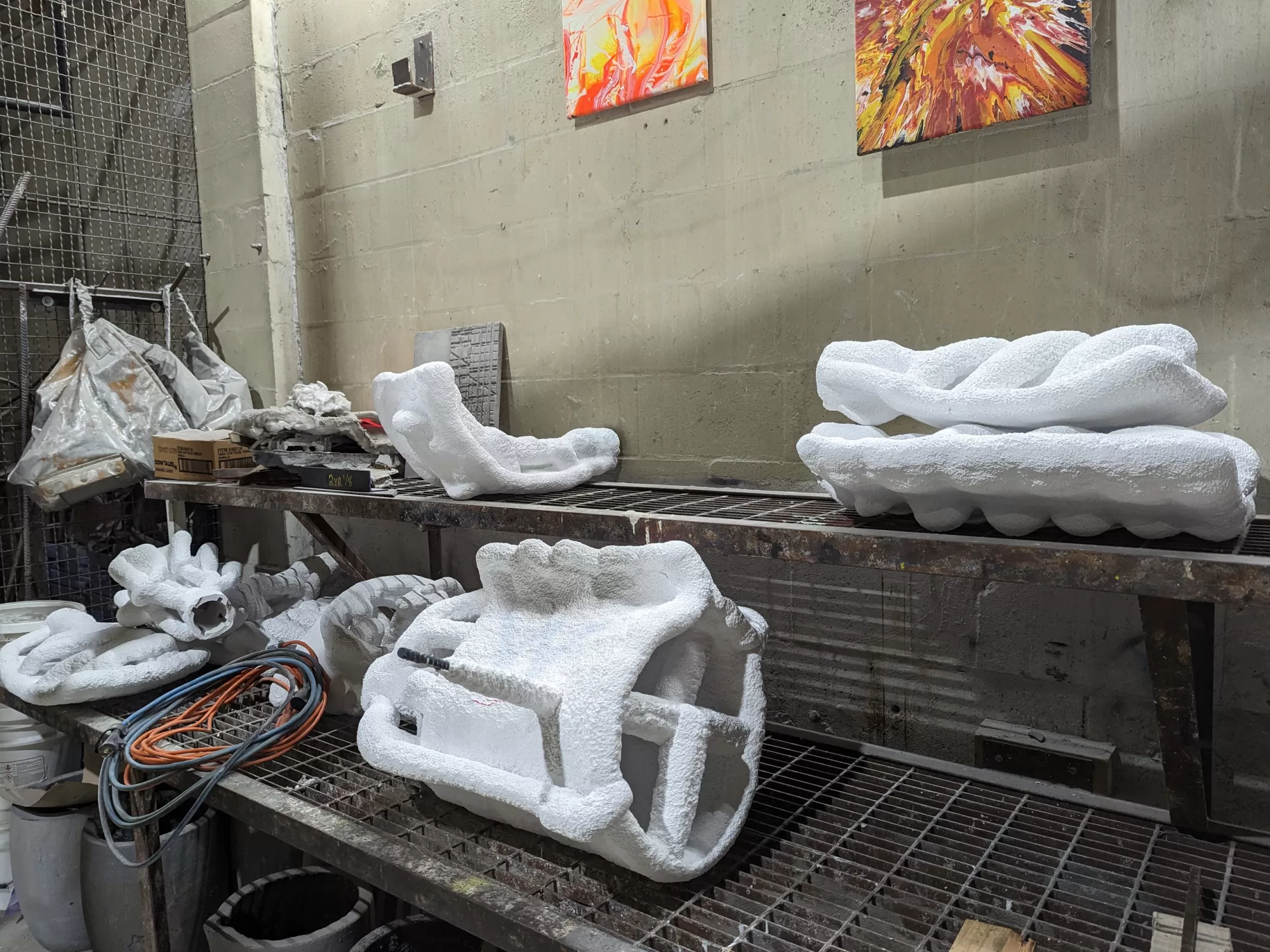Expendable mold casting
Expendable mold casting is a generic classification that includes sand, plastic, shell, plaster, and investment (lost-wax technique) moldings. This method of mold casting involves the use of temporary, non-reusable molds.
Sand casting
Sand casting is one of the most popular and simplest types of casting that has been used for centuries. Sand casting allows for smaller batches to be made compared to permanent mold casting at a very reasonable cost. Not only does this method allow manufacturers to create products at a low cost, but there are other benefits to sand casting, such as very small-size operations. From castings that fit in the palm of your hand to train beds (one casting can create the entire bed for one rail car), it can all be done with sand casting. Sand casting also allows most metals to be cast depending on the type of sand used for the molds.[28] Sand casting requires a lead time of days for production at high output rates (1–20 pieces/hr-mold) and is unsurpassed for large-part production. Green (moist) sand has almost no part weight limit, whereas dry sand has a practical part mass limit of 2,300–2,700 kg (5,100–6,000 lb). Minimum part weight ranges from 0.075–0.1 kg (0.17–0.22 lb). The sand is bonded together using clays, chemical binders, or polymerized oils (such as motor oil). Sand can be recycled many times in most operations and requires little maintenance.
Shell molding
With shell molds, the molding cavity is formed by a hardened “shell” of fine flour instead of a flask filled with sand. The flour is finer than sand casting sand and is mixed with a binder so that it can be heated by the pattern and hardened into a shell around the pattern. Because of the binder, it gives a much finer surface finish. The process is more precise than sand casting. At the foundry, we cast non-ferrous metals such as bronze, aluminum, steel, silver, and gold. This process is ideal for complex items that are small to medium-sized. Common metals that are cast include cast iron, aluminum, magnesium, and copper alloys
Plaster mold casting
Plaster casting is similar to sand casting except that plaster of paris is substituted for sand as a mold material. Generally, the form takes less than a week to prepare, after which a production rate of 1–10 units/hr-mold is achieved, with items as massive as 45 kg (99 lb) and as small as 30 g (1 oz) with very good surface finish and close tolerances.[29] Plaster casting is an inexpensive alternative to other molding processes for complex parts due to the low cost of the plaster and its ability to produce near-net shape castings. The biggest disadvantage is that it can only be used with low melting points in non-ferrous materials, such as aluminum, copper, magnesium, and zinc.
Investment casting
Investment casting (known as lost-wax casting in art) is a process that has been practiced for thousands of years, with the lost-wax process being one of the oldest known metal-forming techniques. From 5,000 years ago, when beeswax formed the pattern, to today’s high-technology waxes, refractory materials, and specialist alloys, the castings ensure high-quality components are produced with the key benefits of accuracy, repeatability, versatility, and integrity.
Investment casting derives its name from the fact that the pattern is invested, or surrounded, with a refractory material. The wax patterns require extreme care for they are not strong enough to withstand forces encountered during the mold making. One advantage of investment casting is that the wax can be reused.
The process is suitable for the repeatable production of shape components from various metals and high-performance alloys. Although generally used for small castings, this process has been used to produce complete aircraft door frames, with steel castings of up to 300 kg and aluminum castings of up to 30 kg. Compared to other casting processes such as die casting or sand casting, it can be an expensive process, however the components that can be produced using investment casting can incorporate intricate contours, and in most cases the components are cast near net shape, so requiring little or no rework once cast.
Evaporative-pattern casting
This is a class of casting processes that use pattern materials that evaporate during the pour, which means there is no need to remove the pattern material from the mold before casting. The two main processes are lost-foam casting and full-mold casting.
Lost-foam casting
Lost-foam casting is a type of evaporative-pattern casting process that is similar to investment casting except foam is used for the pattern instead of wax. This process takes advantage of the low boiling point of foam to simplify the investment casting process by removing the need to melt the wax out of the mold.
Full-mold casting
Full-mold casting is an evaporative-pattern casting process that is a combination of sand casting and lost foam casting. It uses an expanded polystyrene foam pattern which is then surrounded by sand, much like sand casting. The metal is then poured directly into the mold, which vaporizes the foam upon contact.
**Please note not all services in this article are offered by American Bronze
More information:
- Lost Wax Casting method
- Casting process
- Casting – Metalworking
- Non-Expendable Mold Casting
- Patina – Patination
Non-ferrous Metals
- Bronze
- Silver
- Gold
- Stainless Steel
- Aluminum
If you have any questions regarding our process, please feel free to email us at sales@americanbronze.com or give us a call.
International 00+1+407-328-8090
Toll-Free 1+800-881-8090
Local 407-328-8090

